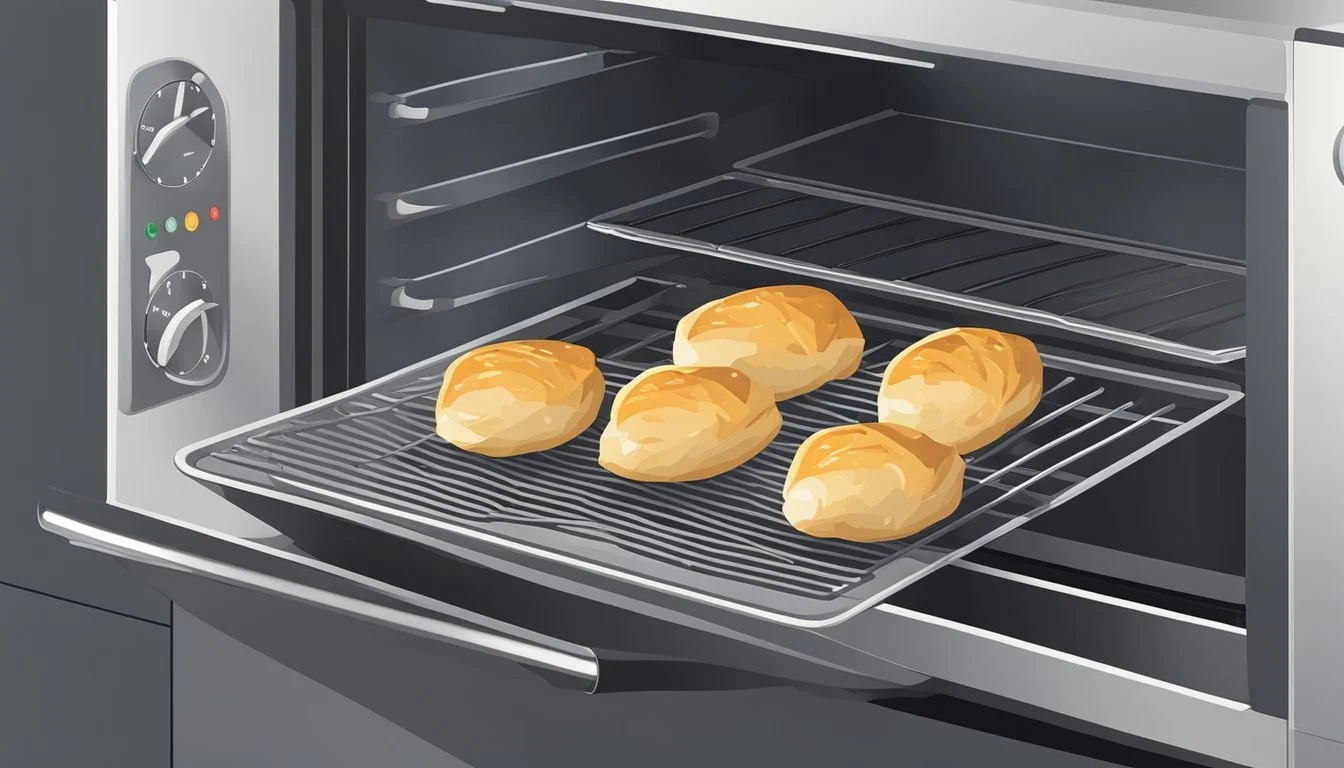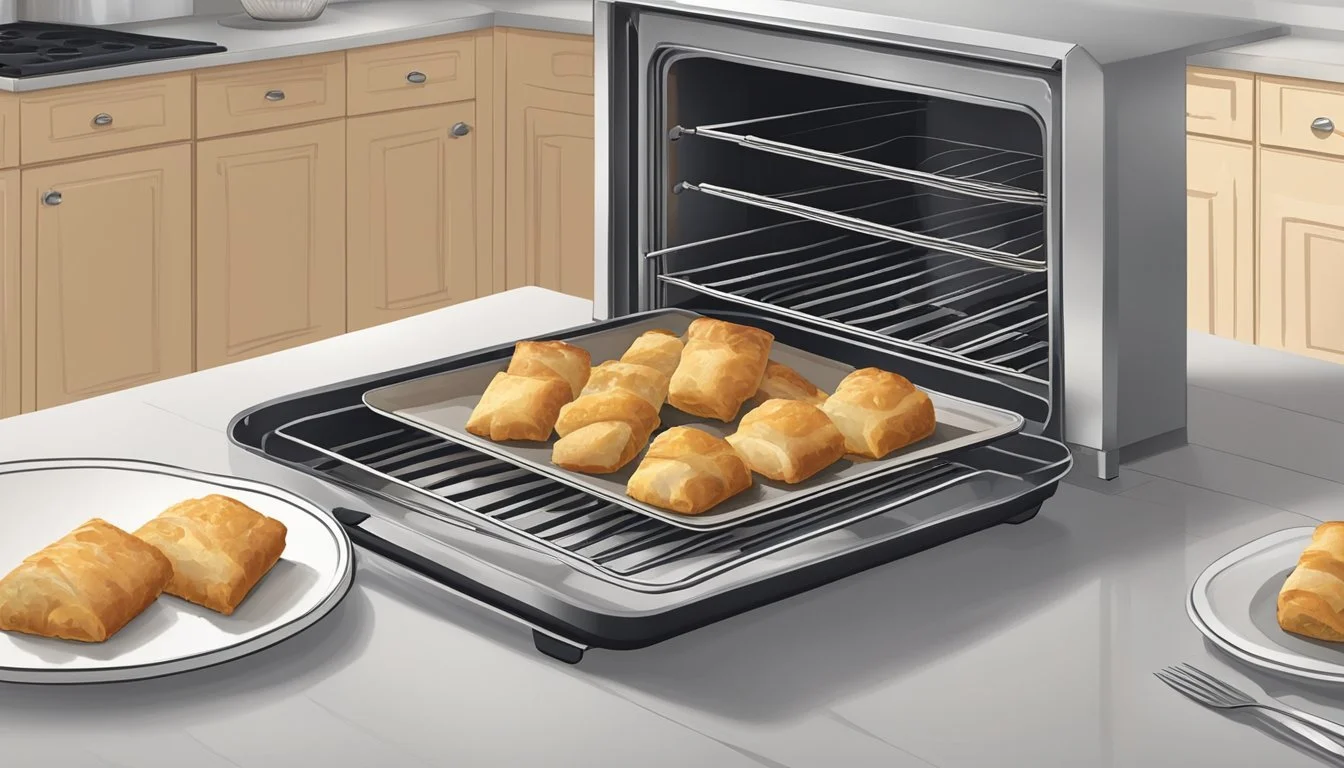How to Reheat Gluten-Free Egg Rolls
Expert Tips for Perfect Results
Reheating gluten-free egg rolls can be a challenge, especially if you're determined to preserve their texture and flavor. The key to reheating gluten-free egg rolls without losing their crispiness is to use a combination of moderate heat and minimal oil. Many traditional methods involve excessive oil or high heat, which can result in soggy, unappetizing rolls.
Begin by adding a small amount of oil in a skillet and allowing it to preheat on medium heat. This helps to ensure the insides heat up evenly without overcooking the exterior. Alternatively, using a toaster oven preheated to 375 degrees Fahrenheit and brushing the egg rolls with a bit of olive oil can achieve that desired crunch.
For those looking to streamline the process, preheating an oven to 350 degrees Fahrenheit and optionally microwaving the egg rolls for a few seconds before oven-heating can make a difference. By following these steps, your gluten-free egg rolls can be restored to their delightful, crispy state.
Understanding Gluten-Free Egg Rolls
Making gluten-free egg rolls involves choosing the right ingredients and using specific techniques to create wrappers that are both tasty and safe for those with gluten sensitivities.
Ingredients and Substitutes
Gluten-free egg rolls use a mixture of gluten-free flours. Common choices include a blend of all-purpose gluten-free flour, tapioca starch, and sweet rice flour. These ingredients mimic the texture and elasticity found in traditional wheat-based wrappers.
Xanthan gum or arrowroot is often added to improve the dough's pliability. For the filling, ingredients like pork, cabbage, and carrots are common, but these are naturally gluten-free. When seasoning, ensure to use gluten-free soy sauce or tamari. Using fresh vegetables and quality meat can significantly enhance the final taste and texture of the egg rolls.
Gluten-Free Wrappers
Creating gluten-free egg roll wrappers can be challenging. The dough must be rolled thinly to achieve a crispy texture. Divide the dough into rectangles and roll them to about 1/8-inch thickness to get the desired thinness.
Maintaining the dough's moisture is essential. Use a wet towel to cover unused dough portions to prevent drying. When frying or baking, ensure the wrappers remain unbroken by handling with care. Adding a bit of olive oil before frying can also enhance the crispiness. Proper storage and handling are key in maintaining these wrappers' delicate texture.
Preparing Your Egg Rolls for Reheating
Properly storing and preheating gluten-free egg rolls ensures they retain their texture and flavor. Follow these guidelines carefully for the best results.
Proper Storage Techniques
To maintain the quality of gluten-free egg rolls, store them in an airtight container right after they cool. This prevents moisture from making them soggy and preserves their crispy texture.
Place the container in the refrigerator if you plan to reheat them within a couple of days. For longer storage, freeze the egg rolls. Lay them out on a baking sheet in a single layer to freeze individually before placing them in a container or zip-lock bag. This method stops them from sticking together, making it easier to reheat only the amount needed.
Pre-Reheating Preparations
Before reheating, let the egg rolls come to room temperature for a few minutes. This step helps them reheat evenly, avoiding cold spots.
For a crispier result, preheat your reheating appliance. If using an oven, set it to 350°F (175°C) and cover a baking sheet with parchment paper to prevent sticking. For air fryer reheating, preheat to the same temperature. If reheating in a skillet, add a small amount of oil and heat on medium until the oil is hot.
By following these steps, you ensure that your gluten-free egg rolls are ready to enjoy without sacrificing texture or flavor.
Reheating Methods
When reheating gluten-free egg rolls, maintaining the texture and flavor is essential. This section offers methods using the oven, stovetop, and air fryer to achieve the best results.
Oven Reheating
Preheat the oven to 350°F (175°C). Place the egg rolls on a wire rack over a baking sheet to allow even heating. Optionally, microwave the egg rolls for 5-10 seconds first to give the inside a head start. Heat them in the oven for about 10 minutes, turning halfway through.
For extra crispiness, lightly brush the egg rolls with oil before placing them in the oven. This method ensures a crunchy exterior while warming the inside evenly. Avoid overcrowding to allow hot air to circulate.
Stovetop Reheating
Heat a skillet over medium heat and add a small amount of oil. Once the oil is hot, add the egg rolls, ensuring they don’t touch. Cook for about 4-5 minutes, turning occasionally to ensure all sides are heated evenly.
Preheating the skillet and oil is crucial. Using too much oil can result in soggy egg rolls, so a light coating is best. This method is quick and can restore the egg rolls' crispy texture effectively.
Air Fryer Reheating
Preheat the air fryer to 375°F (190°C). Place the egg rolls in a single layer in the basket, ensuring they do not touch. Cook for 8-10 minutes, shaking the basket or turning the egg rolls halfway through.
Using the air fryer is an excellent way to achieve a crispy texture without excess oil. For an even better result, lightly brush the egg rolls with oil before placing them in the air fryer. This method is also relatively quick and preserves the gluten-free qualities effectively.
Preventing Sogginess and Ensuring Crispiness
To maintain a crispy texture while reheating gluten-free egg rolls, several techniques are crucial.
Air Fryer Method:
Preheat the Air Fryer: Set it to 350°F (175°C).
Arrange the Egg Rolls: Place them in the air fryer basket, ensuring no overlap.
Flip Halfway: Turn the egg rolls after 1 minute to cook each side evenly, reheating for a total of about 2 minutes.
Oven Method:
Preheat the Oven: Heat to 375°F (190°C).
Bake on a Rack: Use a baking sheet and place a wire rack on top. Position the egg rolls on the rack to ensure hot air circulates around them.
Bake Time: Heat for 10-15 minutes, turning halfway through.
Microwave and Frying Combination:
Microwave First: Heat the egg rolls in the microwave for 30 seconds to warm the inside.
Fry Second: Quick-fry the egg rolls in a skillet with a small amount of olive oil for a crispy finish.
Additional Tips:
Avoid Water Exposure: Excess moisture leads to sogginess, so ensure the egg rolls are dry before reheating.
Oil Coating: A light brush of olive oil on the egg rolls before air frying or baking can enhance crispiness.
Adopting these methods ensures gluten-free egg rolls remain crispy and delicious when reheated.
Complementary Foods and Dishes
Gluten-free egg rolls pair exceptionally well with a variety of sauces, dips, and side dishes, enhancing their flavor and making for a satisfying meal. The right combinations can elevate the experience, making it a perfect option for appetizers or even a main course.
Sauces and Dips
Dipping sauces bring out the best in gluten-free egg rolls. Classic options include soy sauce, though for a gluten-free option, tamari is preferred. Sweet and sour sauce adds a tangy element, combining ingredients like rice vinegar, honey, and ketchup for a balanced taste.
Garlic chili sauce infuses heat and depth, perfect for those who enjoy a spicy kick. A simple mix of honey and mustard can create a sweet yet sharp dip. Rice vinegar blended with soy sauce and a bit of sugar makes a flavorful base for a more complex dipping sauce.
Side Dishes
Side dishes can complement the texture and taste of gluten-free egg rolls. Spring rolls are a fitting appetizer, light and fresh, typically filled with vegetables and sometimes shrimp. Pairing them offers a varied course of flavors and textures.
Steamed or fried rice is a staple that harmonizes well with egg rolls, absorbing the flavorful oils and sauces. Stir-fried vegetables, like snap peas, bell peppers, and carrots, add a nutritious and colorful side. For a lighter option, a cucumber salad with rice vinegar and sesame seeds can provide a refreshing contrast.
Health Considerations and Nutritional Information
Gluten-free egg rolls can be a nutritious option when prepared and reheated correctly.
A typical gluten-free egg roll contains protein, primarily from meat or tofu, which supports muscle health.
Vegetables such as cabbage and carrot are common fillings. They provide essential vitamins and fiber, aiding digestion.
Ingredients like garlic and ginger not only add flavor but also offer various health benefits. Garlic may boost the immune system, while ginger has anti-inflammatory properties.
Sesame oil is often used in the cooking process. It contains healthy fats and antioxidants, which can support heart health.
Here's a snapshot of common nutrient content found in gluten-free egg rolls:
Nutrient Approximate Amount Per Serving Protein 5-7 grams Carbohydrates 15-20 grams Fiber 2-3 grams Fat 6-8 grams Calories 120-150 kcal
When reheating, it's important to use methods that preserve texture without degrading nutritional content. Avoid methods that require excessive oil, as this can increase calorie and fat content.
Methods like air frying or baking are preferable for maintaining a balance between taste and health.
Recipe Variations and Creative Ideas
Exploring different fillings and methods for gluten-free egg rolls can make them an even more enjoyable dish. These creative ideas ensure that everyone, regardless of diet preference, can savor a delicious and crispy egg roll.
Vegetarian and Vegan Options
Vegetarian and vegan fillings offer a fresh take on traditional egg rolls. Common vegetarian ingredients include shredded cabbage, carrots, bell peppers, and mushrooms. These veggies can be stir-fried with soy sauce, ginger, and garlic to create a flavorful filling. For a vegan twist, tofu or tempeh can be added for protein.
Beyond Tofu: Consider using jackfruit as a meat substitute for a unique texture. Jackfruit has a consistency similar to shredded meat and can be flavored to taste like pulled pork.
Adding rice noodles can provide a satisfying crunch and additional texture. For a gluten-free wrapper, rice paper or special gluten-free wonton wrappers can be used. Remember, keeping the wrappers damp while rolling ensures they don’t dry out and crack.
Meat and Seafood Alternatives
For those who prefer meat or seafood, ground beef, chicken, turkey, pork, or shrimp are excellent options. Ground meats should be cooked with seasonings such as garlic, ginger, soy sauce, and a splash of sesame oil for depth of flavor.
Ground pork mixed with shredded cabbage and carrots is a classic combination. Alternatively, ground turkey offers a leaner option without sacrificing taste.
Shrimp lovers can blend shrimp with scallions and bean sprouts for a seafood delight. Pre-cooked shrimp can be sautéed briefly just to combine flavors with the vegetables.
For those looking for a deconstructed option, try an "egg roll in a bowl" or "inside out egg roll". These variations serve the filling without the wrapper, sometimes over a bed of rice or mixed greens, offering a low-carb option.
Whether it’s vegetarian, vegan, or a meat-filled delight, experimenting with different combinations ensures a delightful experience every time.
Storage and Shelf Life after Reheating
After reheating gluten-free egg rolls, they should be stored properly to maintain their freshness.
To store leftover egg rolls, place them in an airtight container.
For optimal results, store the container in the refrigerator.
The shelf life of reheated gluten-free egg rolls in the fridge is typically 2-3 days.
If longer storage is needed, consider freezing them.
In the freezer, they can last up to 1-2 months.
When storing in the freezer, ensure they are wrapped in plastic wrap and then placed in a Ziplock bag or an airtight container.
Proper storage techniques are essential to extend the shelf life and prevent spoilage while maintaining the quality of the gluten-free egg rolls.







